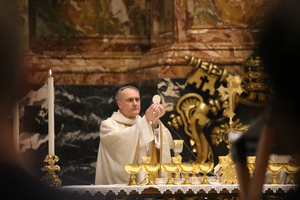Sainthood Cause Advances for Eileen O’Connor, Lay Woman and Mystic
She could become Australia’s second saint.

An Australian archbishop sent Servant of God Eileen O’Connor’s cause for sainthood to Rome on Monday in an important step on the road to leading to the possible declaration of Australia’s second saint.
O’Connor, who at the age of 3 suffered from a debilitating spinal injury, accomplished much during her 28 years of life, founding the Our Lady’s Nurses of the Poor, known as the “Brown Sisters” for their brown habits. The congregation was dedicated to care for the impoverished who were sick.
Archbishop Anthony Fisher of Sydney signed a final decree on Aug. 16 and sent documents detailing evidence for O’Connor’s cause to the Dicastery for the Causes of Saints in Rome on Monday, according to the archdiocesan paper The Catholic Weekly. Her cause for sainthood first opened in February 2020.
O’Connor would be Australia’s second saint, following St. Mary of the Cross MacKillop, who was canonized in 2010 by Pope Benedict XVI.
Eileen O’Connor was born in Melbourne in 1892, the eldest of four children, to devout Irish Catholic parents.
Due to a curvature of the spine, O’Connor was 3-foot-9, and could not stand or walk for much of her life.
She suffered from tuberculosis of the spine, stunted growth, periods of blindness, long periods of paralysis, and extreme nerve pain, and she had a condition that is now known as transverse myelitis, which involves inflammation of the spine.
When her father died, the family experienced financial challenges. Father Edward McGrath, a parish priest and member of the Missionaries of the Sacred Heart, found accommodations for the family.
O’Connor later worked with Father McGrath to found a congregation of nurses to care for those who were poor and ill. She told Father McGrath that she had experienced a vision of Mary, who encouraged her to embrace her suffering for others.
They faced many challenges with the congregation initially and were accused by a Sacred Heart missionary of maintaining an improper relationship. As a result of the allegations, which were later disproven, Father McGrath faced limitations in his role as a priest. His order threatened him with expulsion unless he ceased contact with O’Connor. He refused and traveled to Rome, where he successfully appealed his case and was reinstated in his order.
In 1915, O’Connor, with the help of her nurse, traveled to Rome and London to support his cause in 1915. She was granted an audience with Pope Benedict XV.
While Father McGrath’s appeal was successful, he was prevented from returning to Australia for almost three decades. He traveled to Britain where he served as a chaplain for the British Army during World War I and received the Military Cross and a nomination for the Victoria Cross for acts of bravery in war.
O’Connor continued with her work on her own. She led the congregation, who called her “Little Mother,” until she died at age 28 on Jan. 10, 1921, of chronic tuberculosis in her spine.
When her remains were later exhumed and moved to the chapel at the congregation’s home in 1936, her body was found to be incorrupt.
Our Lady's Nurses for the Poor continued its ministry in Australia. Now an independent ministry of the sisters, the Brown Nurses serve as employed nurses who care for the sick and the poor in their homes.
Canonization Process
Father Anthony Robbie, a priest of the Archdiocese of Sydney and diocesan postulator of O‘Connor’s cause, will be traveling with Archbishop Fisher to Rome to present the evidence to the dicastery after four years of investigation.
Father Julian Wellspring oversaw the cause, which began about four years ago in February 2020.
O’Connor was declared a “Servant of God” in 2018.
The modern-day path to sainthood entails a three-stage process in which individuals are declared in succession venerable, blessed and saint.
Church authorities examine and investigate the life of the person at least five years after his or her death, then send the results to the Dicastery for the Causes of Saints, where nine theologians will vote on whether the person has lived a virtuous, heroic life. If the panel agrees, the information will be reviewed by cardinals and bishops and then brought before the pope. With his approval, the dicastery will declare the person “Venerable.” In the case of martyrs, the title of “Blessed” is automatically given.
A “Venerable” is declared “Blessed” when a miracle attributed to his or her intercession is confirmed by a canonical investigation. A “Blessed” can be canonized after the confirmation of a second miracle.
















